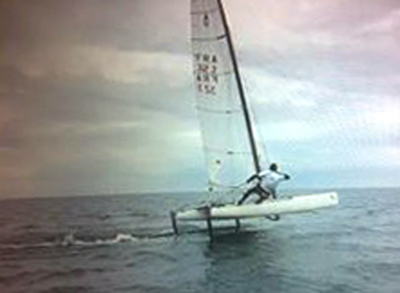Specifically, we worked to gain data on how different foil configurations affect dynamic behaviour during turns in strong wind.
The results confirmed observations we hear regularly from experienced Moth sailors, as well as those who race foiling multihulls such as the NACRA F20 Carbon FCS:
Being foilborne on the upwind leg makes the bearaway a lot safer.
Intuitively it is easy to understand that a foil has the ability to ‘push back’ with increasing force as the bow-down moment from the rig increases. But this is only part of the picture.
In displacement mode, an increase in bow-down trimming moment must result in some bow-down trim in order to move the centre of buoyancy forward.
More volume has to be displaced closer to the bow so that a restoring bow-up moment can exist to counter the increasing bow-down moment from the rig (which in turn is a result of sail force increasing and rotating to point more forward during the bearaway).
A secondary effect of the bow-down trim is that the rig increasingly pushes down, effectively increasing displacement.
All the while drag is increasing, speed is diminishing (or increasing at a reducing rate), and available volume (forward buyancy) is running out.
Staying on the foils instead allows the foil/elevator system to dynamically counter the changing sail vector.
Less obvious, and possibly more important, is the fact that, with less drag and smoother acceleration, the apparent wind stays forward so bow-down trimming moment is much smaller.
To reap the benefit, foiling upwind has to be competitive.
This can only be the case when maximum righting moment is available.
To maximise righting moment the leeward foil must be able to carry the boat at moderate (upwind) speeds and give some heave stability unaided.
Safety is perhaps the most compelling argument for ending the absurd restrictions imposed on the A Class by a shrinking minority.




